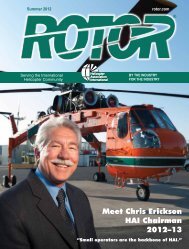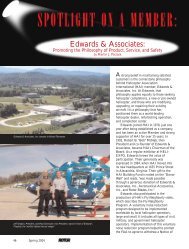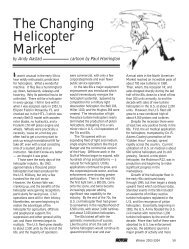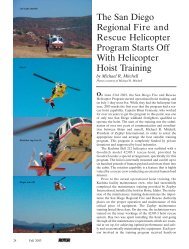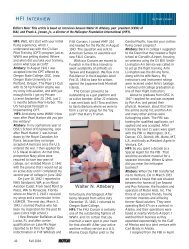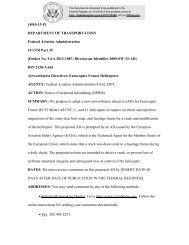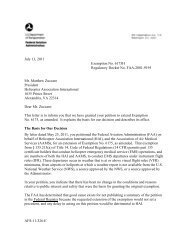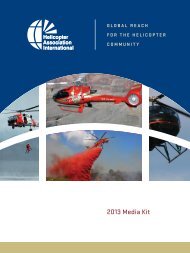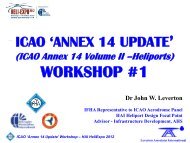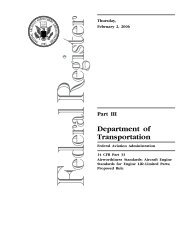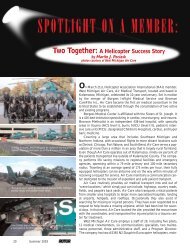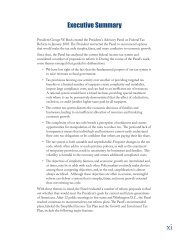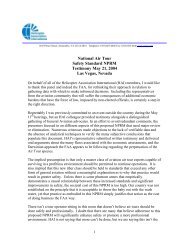Convention Preview (pdf) - Helicopter Association International
Convention Preview (pdf) - Helicopter Association International
Convention Preview (pdf) - Helicopter Association International
You also want an ePaper? Increase the reach of your titles
YUMPU automatically turns print PDFs into web optimized ePapers that Google loves.
of this technology in air medicine, firefighting, and<br />
law enforcement. Although we currently have nightvision<br />
devices and dashboard-mounted synthetic<br />
vision systems, this new version will add real-time<br />
sensors (the enhancement) to a helmet-mounted<br />
display. The resulting “view” will allow pilots to see<br />
through all types of obstacles in the degraded visual<br />
environment, including fog, snow, dust, and clouds.<br />
NextGen Flight Deck Technology<br />
for Runway Incursions<br />
March 5, 2013 || 8:30 am – 9:30 am || Flight Operations<br />
Instructor: Robert Joslin, chief scientific and technical<br />
advisor for flight deck technology, Federal Aviation<br />
Administration<br />
This course will analyze the effectiveness of current<br />
safety controls for reducing runway incursions,<br />
consider precedents from regulation-based<br />
technological controls, and explore NextGen runway<br />
incursion awareness systems as aircraft flight<br />
deck equipage. Reduction of runway incursions<br />
has been a top strategic objective for the Federal<br />
Aviation Administration over the last decade and<br />
is repeatedly listed on the National Transportation<br />
Safety Board’s Most Wanted List of transportation<br />
safety improvements.<br />
Operational Risk Management:<br />
Beyond the Planning<br />
March 6, 2013 || 4:00 pm – 5:00 pm || Flight Operations<br />
Instructors: Dan Deutermann, managing director,<br />
The Squadron, Inc.; and Rick Christoffersen, director<br />
of safety, The Squadron, Inc.<br />
The challenge is to provide a simple framework<br />
of a proven risk assessment tool, tailor it for a<br />
helicopter mission, and then understand how to<br />
use its information beyond preflight planning. The<br />
course will use a practical exercise to demonstrate<br />
how operators can tailor the aid with inputs from<br />
their fellow operators. Attendees will also learn how<br />
to use the tool during mission execution and during<br />
postflight to capture lessons learned and augment<br />
safety awareness.<br />
Rotor Rooter:<br />
Rooting for Autorotational Success<br />
March 5, 2013 || 2:30 pm – 3:30 pm || Flight Operations<br />
Instructor: Dr. Steve Sparks, principal operations<br />
inspector, Federal Aviation Administration<br />
The Rotor Rooter Program is an FAA Safety Team<br />
(FAASTeam) education initiative aimed at reducing<br />
light-helicopter training accidents in support of<br />
the <strong>International</strong> <strong>Helicopter</strong> Safety Team’s accident<br />
reduction goals. Analysis reveals that approximately<br />
Las Vegas • March 4–7<br />
18 percent of all helicopter accidents occur during<br />
training, while a large portion of these accidents<br />
occur during autorotation training.<br />
Scenario-Based Training<br />
for Pilot Decision Making<br />
March 5, 2013 || 4:00 pm – 5:00 pm || Flight Operations<br />
Instructor: Katherine Hilst, owner, manager, and<br />
principal trainer, Safety Design Consulting, LLC<br />
Scenario-based training (SBT) is a system that<br />
incorporates real-world experiences that are scripted<br />
to meet flight training objectives from a specific<br />
operational context. It can be utilized for both initial<br />
training and more advanced operations. SBT allows<br />
trainees the opportunity to improve pilot decisionmaking<br />
skills in a targeted operational context. This<br />
course covers the limitations of human decision<br />
making as it applies to pilots and demonstrates the<br />
use of various SBT approaches.<br />
Spatial Disorientation / Flying<br />
on Night-Vision Goggles<br />
March 6, 2013 || 1:00 pm – 2:00 pm || Flight Operations<br />
Instructor: Rich Weber, chief pilot F/W, Jacksonville<br />
(FL) Sheriff’s Aviation Unit<br />
This course is for pilots and crewmembers flying<br />
rotary-wing aircraft. The course covers background,<br />
statistics, factors affecting spatial disorientation (SD),<br />
types of SD, and prevention and treatment of SD.<br />
Topics include becoming spatially disorientated while<br />
flying on night-vision goggles (NVGs), including the<br />
causes, effects, limitations, and skills needed to help<br />
prevent SD while flying with NVGs. Video is used in<br />
this presentation.<br />
Training Safety or Training Safely<br />
March 6, 2013 || 8:30 am – 9:30 am || Flight Operations<br />
Instructor: Nick Mayhew, general manager, Bristow<br />
Academy (Titusville, FL); chairman, IHST JHSIT<br />
Training Working Group<br />
“Training Safety” is using training tools to develop a<br />
safe attitude in pilots, be they students, commercial<br />
pilots, or instructors. It is the pilot in command’s<br />
responsibility to use all available tools to assess risks,<br />
execute the flight, and return everybody in a safe<br />
and relaxed manner. “Training Safely” is the idea<br />
that both instructor (or examiner) and student pilot<br />
have a stake in safely conducting the flight. The<br />
course will discuss and develop this theme.<br />
rotor.com/heliexpo<br />
9<br />
hai Rotor Safety Challenge – Free



